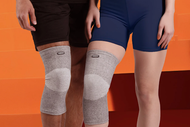Discover common causes of elbow pain when mobile and effective treatments to improve your recovery journey and regain your mobility!
Discover common causes of elbow pain when mobile and effective treatments to improve your recovery journey and regain your mobility!
As you age and stay active, elbow pain can creep in, often becoming a constant companion. The elbow, integral to many physical activities, is vulnerable to a variety of conditions, each with distinct causes and symptoms.
Whether you're a retired athlete or someone consistent with your workout regime, understanding these conditions is the first step toward recovery.
This article breaks down 4 most common elbow pain causes when mobile, provides practical ways to alleviate discomfort, and shows how our recovery wear can support your journey toward pain-free mobility!
Diving deeper, let's examine the four common conditions that might be causing that nagging pain in your elbow as you maintain your active lifestyle.
Tennis elbow, or Lateral Epicondylitis in medical terms, is a condition where the tendon (a tough band of tissue) that helps your wrist bend backward gets swollen. This tendon is called the extensor carpi radialis brevis and is located near your elbow.
This condition often manifests as pain located on the outside of your elbow, potentially extending down the forearm. Typically identified in individuals between the ages of 30 and 50, it's mostly linked to overuse or repeated action of the forearm muscles near the elbow joint.
While not exclusive to sports participants, the term originates from the strain put on the forearm muscles during tennis backhand strokes.
Causes of tennis elbow include:
Wrong backhand stroke in tennis
Use of a wrongly strung tennis racket
Jobs with frequent hand use, like butchers, dentists, and carpenters
Any activity that puts repeated stress on the elbow joint
Golfer's elbow, medically known as Medial Epicondylitis, presents as pain centered around the bony bump on the inside of your elbow, often extending into the forearm. It's a form of tendonitis caused by inflammation in the tendons that connect the forearm to the elbow.
Despite its name, it's not exclusive to golfers. Tennis players, amongst others who frequently use their wrists or clench their fingers, are susceptible to this condition. The pain, which might manifest suddenly or over time, can also be accompanied by stiffness in your elbow, tenderness, and a possible tingling or numbness in your fingers.
Causes of golfer's elbow include:
Wrong technique in racket or throwing sports
Overuse of topspin or using a wrongly sized racket
Improper weight-lifting technique
Any repetitive flexing, gripping, or swinging motion that strains the tendons
Cell phone elbow, technically termed cubital tunnel syndrome, is a condition resulting from the pinching of the ulnar nerve behind the elbow, much like carpal tunnel syndrome impacts the hand.
The symptoms often present as a tingling or numbness in the texting thumb or ring finger, with the potential for elbow pain.
Despite the condition's name, cell phones don't directly cause this syndrome, but extended cell phone use can exacerbate it. Specifically, prolonged periods of bending the elbow can aggravate or accelerate the onset of symptoms.
The condition's prevalence is higher among individuals predisposed to ulnar nerve compression due to their anatomical characteristics.
Causes of cell phone elbow include:
Bending the elbow for long periods, such as during extended mobile phone use
Sleeping in an elbow-bent position
Holding arms bent and close to the head for long durations
Anatomical predisposition to a narrower cubital tunnel
Elbow Bursitis, a condition primarily affecting the olecranon bursa located at the tip of the elbow, presents as painful swelling around the elbow joint.
The olecranon bursa, one of many bursae throughout the body, serves as a cushion between bones and soft tissues, containing a small amount of lubricating fluid that allows free tissue movement.
However, when irritated or inflamed, this bursa fills with excess fluid, leading to Bursitis. The symptoms, including pain and swelling, may appear suddenly or develop over time and can be prompted by a variety of causes.
Causes of elbow Bursitis include:
Trauma, such as a hard blow to the elbow, causes the bursa to swell
Prolonged pressure from leaning on the elbow for extended periods on hard surfaces
Infection, due to a break in the skin allowing bacteria into the bursa sac
Certain jobs and athletic activities that involve consistent elbow pressure
This all leads to a timely recovery process that will require you to wear a brace for bursitis.
Managing pain in the elbow effectively requires a combination of professional medical advice and self-care routines. Here are some common treatments that can help alleviate your discomfort.
Professional guidance from a physical therapist can significantly improve mobility and reduce pain. Therapeutic exercises and stretches support the healing process, enhancing muscle strength and flexibility around the elbow.
Over-the-counter non-steroidal anti-inflammatory drugs (NSAIDs) can help reduce pain and inflammation. However, it's critical to follow dosage instructions and consult your healthcare provider for long-term use.
Giving your elbow a break from strenuous activities can be beneficial. Rest allows your body's natural healing processes to take over, reducing the risk of further injury.
Applying a cold pack to the affected area for 15 minutes at a time can help alleviate pain and reduce inflammation. That said, it's important to wrap the cold pack in a cloth to protect your skin.
Reach out to your healthcare provider if you suffer from persistent or severe pain in your elbow. They can provide appropriate diagnostic tests and treatments, potentially including corticosteroid injections or elbow surgery for more serious cases.
If you're starting your elbow healing journey, recovery wear, such as an elbow pad or an elbow sleeve, can benefit you significantly. This piece, designed to aid in recovering from elbow-related ailments, offers functional features like enhanced blood flow, accelerated recovery, and pain relief.
These benefits stem from its advanced, eco-friendly design. The thermoregulating bamboo charcoal fabric optimizes the natural healing process without restricting mobility. On top of that, the form-fitting, breathable, and moisture-wicking capabilities offer constant comfort.
Check out our offer!

Incrediwear is on...
September 25, 24

Pain management i...
September 23, 24

Recovery wear is ...
September 12, 24